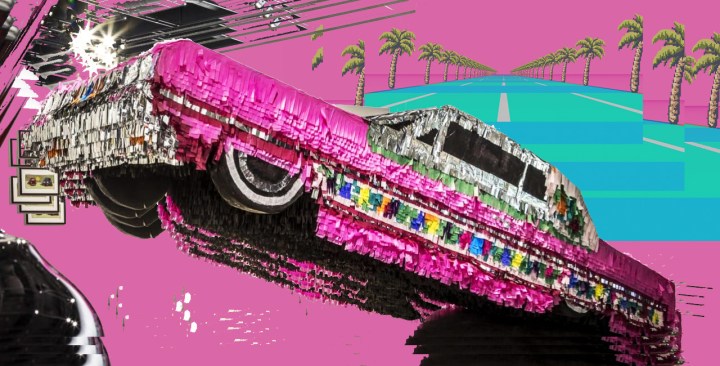This Mexican-Guatemalan Artist Created an Epic Life-Size Lowrider Piñata

Art by Alan López for Remezcla
When Justin Favela isn’t co-hosting the Latinos Who Lunch podcast with Emmanuel Ortega, he’s transforming piñatas from party staples to impressive structures that make statements on his culture. One of his most awe-inspiring works – a built-to-scale lowrider piñata titled “Gypsy Rose Piñata” – currently hangs at the Petersen Automotive Museum in Los Angeles. Though Favela has previously called his piñatas a “gimmick” and questioned whether he was “making work for white people,” he’s drawing attention to piñata making as an art form. At the same time, he’s dabbling in the tradition of Chicano art in his hometown of Las Vegas – a city that doesn’t have a strong presence in the movement. In the past, Favela’s been called “Las Vegas’ one-man Chicano movement.”
The half Guatemalan, half Mexican artist began looking to his background for inspiration during his college years. “When I was in school at [University of Nevada, Las Vegas], I started thinking about my identity as a Latino – and about making my art about my identity,” Favela told KCET. “It’s a decision I just dove into headfirst.”
And that led him to piñatas – an art form that many don’t take seriously. As he told the Los Angeles Times, “People see piñatas as craft or artisanal work. But I like the idea of elevating that material, of skewing the perception.”
His “Gypsy Rose Piñata” piece is on display until June 3, 2018 as part of The High Art of Riding Low: Ranflas, Corazón e Inspiración exhibition. Organized by Denise Sandoval – an independent curator – the exhibition explores all facets of lowrider culture. Sandoval learned about Favela’s work because of a green lowrider piñata he created in 2013 for a Las Vegas exhibit titled Next Exit: Route 66, LA Observed reports. When Sandoval asked if the piñata still existed, she learned that Favela broke it down for parts in 2015. So when Sandoval asked him if he’d create a new one, he decided to model his piece after the iconic Gypsy Rose, a pink 1964 Chevy Impala built by the late Jesse Valadez. This car is also on display at Petersen.
For Favela, exhibiting his work at this venue couldn’t be a better fit. The lowrider, like his work, is representative of Chicano culture. “The car is such an important part of history here in the United States. It’s a symbol of American progress. And the lowrider is a way that our community was able to take something so American and make it our own.” At the same time, his piece flips the script on the typically masculine lowrider culture.
“Gypsy Rose Piñata” is not his only work currently displayed in a museum. A piece titled “Fridalandia” is part of the Mi Tierra exhibition at the Denver Art Museum. The piece – on view through October 22 – is a paper version of the garden Frida Kahlo tended to in her Casa Azul. Favela’s creation is based off of the 2002 Frida movie.